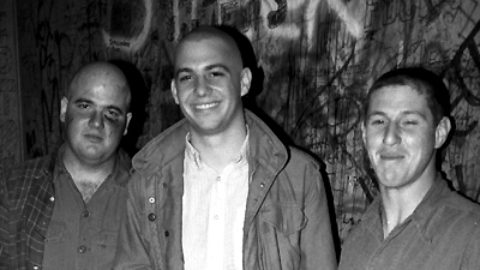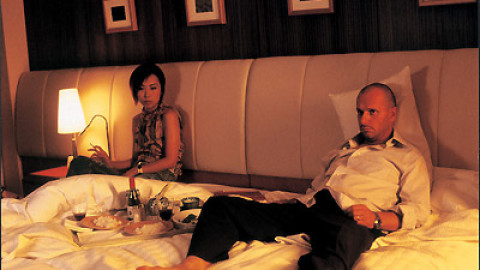Bombast: Where Were You in ’82?
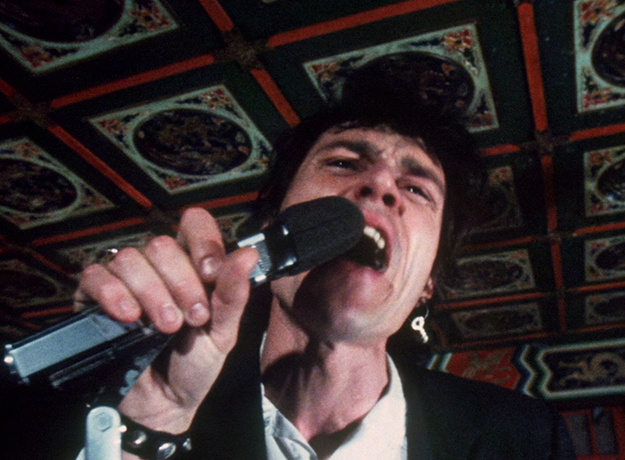
The Decline of Western Civilization
Most of the subjects of The Decline of Western Civilization, Penelope Spheeris’s 1981 boots-and-braces-on-the-ground documentary on Southern California hardcore, can’t have had much reason to think that posterity would care a tittle about what they had to say—though this probably didn’t prevent some of them from hoping it would anyway. The exception, in terms of reaping positive feedback from establishment sources, are the group X, who were already on their way to becoming critical darlings when they sat down with Spheeris. At the time of the film’s release, their debut album Los Angeles had just been released on Slash Records, garnering a favorable review from Rolling Stone magazine, something which would elude most of their contemporaries working in “punk” or “hardcore” idioms—having Doors keyboardist and certifiable Boomer icon Ray Manzarek as the producer can’t have hurt. (Germs, another act on the Decline roster, had just gone into the studio with Joan Jett, and would shortly thereafter record songs for the soundtrack of William Friedkin’s 1980 Meatpacking District giallo Cruising.) Front woman Exene Cervenka shows off a bouquet of two dozen pink roses sent by the management of the Whiskey-A-Go-Go to the camera, a thank-you for the business brought in by X’s shows, and muses on the potential problem posed by “We’re Desperate,” one of their signature tunes: “At one point I started thinking: ‘There’s gonna come a point where we’re gonna keep performing this song, people are gonna be going, ‘Sure, they’re desperate. I just paid six dollars to see this band. They’re not desperate.’”
Such a point isn’t arrived at anywhere in Decline of Western Civilization, which was filmed, per its opening text, from “December 1979 through May 1980,” though one of the particular pleasures of the latter-day hardcore-scene-reminiscence documentary is watching subjects wax nostalgic about their former destitution in front of a background of material comfort, modular shelves full of carefully catalogued LPs and professionally framed flyers. Decline, which was released to Blu-ray and DVD for the first time a few weeks ago in a boxed set with its two sequels, came before any official narratives had fallen into place and was an eyewitness to an important juncture in the history of the scene (or scenes) that it documents. This was when the term “New Wave” had only recently entered the vernacular, a phenomenon whose very existence is memorably rebutted by one of the films’ most memorable subjects, Slash Magazine writer Claude Bessy, aka Kickboy Face. As a transcription fails to convey the particular pleasures of Bessy’s rhetoric, I recommend that you watch his entire monologue here:
Bessy is seen performing with his short-lived band, Catholic Discipline, at the Hong Kong Café, which at that time was embroiled in a booking war with Madame Wong’s, a neighboring venue in downtown Los Angeles Chinatown which had banned punk acts after a near riot at an X / The Bags show, and was now billing itself as the flagship venue for New Wave. Such institutional bans were not uncommon: for instance, Germs lost one of the few remaining venues willing to host them after a Christmas ’79 show at the Whiskey turned into a hail of glass bottles—a far cry from a bunch of pink roses.
Among the genres that Bessy deigns to deem legitimate in his monologue are “noise, punk, power pop, ska, rockabilly,” though he doesn’t drop another term that’s shortly to enter usage: hardcore. Hardcore is to rock ’n’ roll history what mise en scène is to film aesthetics—a term that a great many people use with hardly anyone having landed on a single, satisfactory definition of what it is. Roughly speaking, it’s the new breed of breakneck punk which Brendan Mullen, founder of the club The Masque, is seen to describe in Decline, defined by bands like Germs and Black Flag who produce a musical maelstrom that’s “upwards of 250, 300 beats a minute.” In Mullen and Marc Spitz’s oral history We Got the Neutron Bomb: The Untold Story of L.A. Punk, originally published in 2001 and concerned with describing (in part) the same moment that Spheeris’s film captured, Germs drummer Don Bolles describes the beginning of “hardcore”:
[Black Flag guitarist] Greg Ginn said he never heard the term “hardcore” until ’82, which is total bullshit. Germs started Southern Californian “hardcore,” and Black Flag codified it, and Greg knows it, but old BF had this brutal Paleolithic quasi-Calvinist work ethic thing happenin’ . . . they worked their asses off, night and day, twenty-four/seven, as opposed to Germs, who barely even liked getting up in the morning.
The generally accepted origin of the phrase “hardcore”—stemming from Vancouver band D.O.A.’s album Hardcore ’81—is given in the 2006 documentary American Hardcore. The film, directed by Paul Rachman and written by Steven Blush, is an adaptation/tie-in to Blush’s own 2001 American Hardcore: A Tribal History, an oral history which offered a survey of hardcore’s metastasis to the status of a nationwide phenomenon, and the various local varietals which sprang up in the wake of a touring Black Flag. (Bobby Steele of Lodi, New Jersey’s Misfits, offers another definition: “Like hardcore porn, it’s right down to the core, it’s the real deal.”) The turn-of-the-century boom in volumes like American Hardcore, still ongoing, can be explained by the runaway success of Legs McNeil and Gillian McCain’s 1996 Please Kill Me: The Uncensored Oral History of Punk, which, along with Robert Caro’s The Power Broker, was one of the books you’d find in every Williamsburg apartment in the early-to-mid-Aughts, and the only one you could say with certainty that the residents had finished. (It’s full of salacious anecdotes.) As pop-music oral histories begat films, so films beget oral histories—witness a three-part feature at VICE’s Noisey, inviting participants in the Decline saga to reminisce on their roles and the film’s lasting impact, all assembled by Tony Rettman, also author of a tome called NYHC: New York Hardcore 1980-1990.
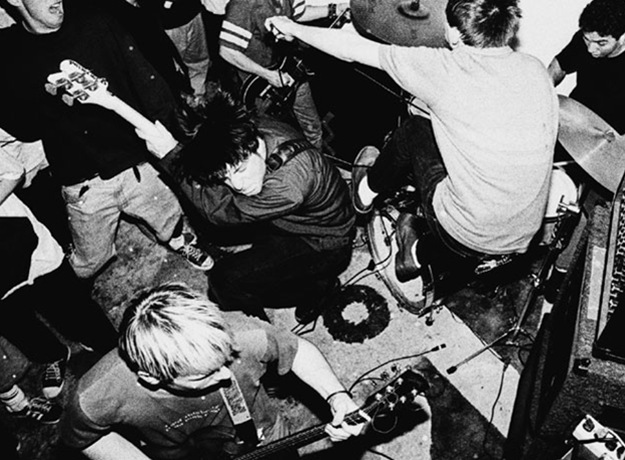
American Hardcore
Blush and Rachman’s American Hardcore film was part of a boom of its own, that of career-retrospective music docs—low-overhead productions with an inscribed audience of fans whose subjects, when still living, had usually reached sedentary middle age and were in an expansive, backward-looking frame of mind. This is worlds apart from Decline, which, while dealing with two increasingly distinct subsets of SoCal underground rock ’n’ roll, was more intent on capturing the heat of the moment than on spelling out the geographic and cultural schism with, say, cutesy interstitial animations. The first of the abovementioned subsets is the group who are sometimes referred to in Mullen’s book as the “Hollywood party punks,” represented by Alice Bag Band, Catholic Discipline, and X—a little older, a little more art- and theory-inflected. The second are the new wave of bands (and kids) coming from the unfashionable precincts away from the epicenter of downtown, from places like Huntington Beach, Hermosa Beach, and San Pedro in the South Bay; Costa Mesa and Fullerton in Orange County; bands including Black Flag, the Circle Jerks, fronted by former BF member Keith Morris, or T.S.O.L., who would feature in Spheeris’s first fiction feature, Suburbia (84).
“Yeah, that chick passed out and I pissed in her face, so what?” says T.S.O.L.’s Jack Grisham, smiling for the camera as he flaunts his resume of criminal behavior in American Hardcore—the rare case where the rule of “older, wiser” doesn’t prevail. For the most part the reminiscence films tell (and re-tell) a super-posi “Hardcore saved my life” narrative, omitting the adolescent provocation that Spheeris’s film dwells on, the very things that make Decline a unique document from Ground Zero, untouched by hindsight circumspection or revisionism. Spheeris emphasizes the visceral charge of the music, the outré fashions and shock-value posturing, and the desperate, marginal lifestyles above what, in some eyes, would be the enduring legacy of this period: the laying of a groundwork for a “For us, by us” DIY culture, with the music anchoring a grassroots organization that encompassed independent labels, self-published zines, and a national network of stopovers for touring bands, almost all undertaken in a resolutely anti-careerist fashion, without hope of turning anything more than a subsistence-level profit. The youthful idealism behind this, as well as the unglamorous reality, are both on display in Adam Small and Peter Stuart’s Another State of Mind (84), a tour doc which follows California acts Youth Brigade and Social Distortion on a cross-country school-bus tour, including a breakdown in Washington, D.C. and a stay at the Dischord Records house with Minor Threat and Ian MacKaye.
I got the idea to write something about the cottage industry of hardcore documentaries around the time that it was announced that Salad Days: A Decade of Punk in Washington, DC (1980-90) was going to have a run at IFC Center in New York.* Music docs have piled up in the last decade. While the rockumentary, à la the original Decline, has its own storied legacy, the fact that something like the same “oral history” model which proved popular in bookstores also worked on the screen was proven by the success of VH1 programs Legends and Behind the Music, which first aired in 1995 and 1997, respectively. In the 2000s, a passel of talked-about rock docs appeared, including End of the Century: The Story of the Ramones (03), Some Kind of Monster (04), and Dig! (04), a subset of the glut of artist tie-in docs which continues to this day. Many contemporary music docs are more in the line of info-dumps than documentary art, though occasionally, as in the case of A Band Called Death (12), they may help to draw attention to neglected artists; at the third edition of Film Society’s music-doc series Sound + Vision, which begins at the end of July, one can see American Hardcore co-director Rachman’s Lost Rockers, dedicated to Sixties and Seventies singer-songwriters from different genres who experienced temporary fame (or just missed it). Contemporaneously to the rock-doc boom came an explosion of rock/pop/rap biopics, including Ray (04), Walk the Line (05), Control (07), Notorious (09), The Runaways (10), what a friend recently called “that unappealingly cast Brian Wilson biopic,” and the forthcoming Straight Outta Compton. (The best of the music-milieu films from this period—by my reckoning, Clean, Last Days, and Crazy Heart—all have the good sense to position their narratives at a strategic distance from Based on a True Story nitpicking.)
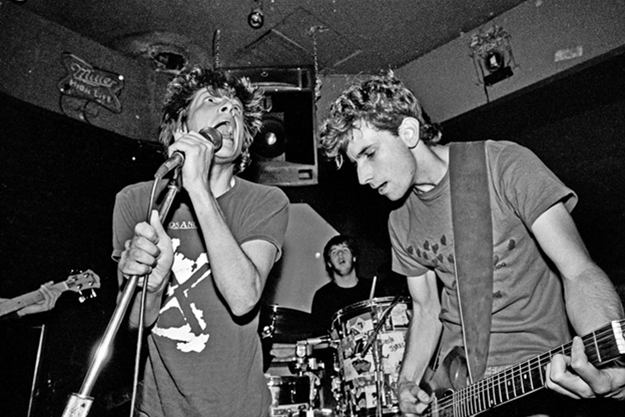
Circle Jerks: My Career as a Jerk
As music docs proliferate, so too does the hardcore documentary. Today, one can view films about the Circle Jerks (Circle Jerks: My Career as a Jerk, 12); The Minutemen of San Pedro (We Jam Econo, 05); pop-punk godfathers The Descendents (Filmage, 13); Boston’s Slapshot (Chip on My Shoulder: The Cautionary Tale of Slapshot, 09); MacKaye’s most famous post–Minor Threat project, Fugazi (Instrument, 03); and even a multi-part Noisey series on the New York hardcore band Judge. Beyond the movies dedicated to single groups, there are those dedicated to parochial scenes, including the abovementioned Salad Days, All Ages: The Boston Hardcore Film, and, much the best of the bunch because it gives the archival performances some space to play through and deals with a less documented-to-death scene, You Weren’t There: A History of Chicago Punk 1977-84 (07). A few months ago, the trailer for a supposedly forthcoming documentary called Destroy Cleveland, “about the Hardcore music scene in Cleveland from ’86 to the present . . . notorious for it’s [sic] violence and mayhem” crossed my desk, promising such inducements as an interview with One Life Crew drummer Chubby Fresh at his T-shirt store in the Great Lakes Mall in Mentor, Ohio.
Not very much has been written about these movies in cinephile circles, in part because they are not particularly formally ambitious, and hold little interest for someone without a pre-existing interest in the subject matter. (The exception is Jem Cohen’s Instrument which, by virtue of its long gestation and level of access to the subjects, is a bit of a margin-walker in this company to begin with.) If nothing else, they’re indications of a culturewide nostalgia kick which is the running through-line of this column, a drive to reclaim the whole of “underrated” cultural history and give it its due, a “sepia toned” memory, to quote MacKaye in Salad Days—a film which takes its name from the last EP released by Minor Threat, whose title track delivers an epigraph for the D.C. scene: “On to greener pastures / The core has gotten soft / Look at us today / We’ve gotten soft and fat / Waiting for the moment / It’s just not coming back.”
Decades after the down-and-dirty Decline of Western Civilization, a film which captures a scene emerging from the prehistoric miasma, the hardcore documentary has developed its own paint-by-numbers template. The first step is to place what’s to come within a wider cultural context. This is achieved by way of a passing reference to the dominant conservative political temperament of the time, shorthanded in archival images of early-Eighties political villains like Iran-Contra star Lt. Col. Oliver North, Attorney General Ed Meese, and of course the 40th President of the United States. Ronald Reagan is to the hardcore documentary what the cutaway to U.K. garbage strikes or the Queen’s Jubilee or some prog-rock outfit’s huge drumkit is to the punk doc—a metonym for the great big cultural Wrong that’s there to be rebelled against. (Unmentioned is an equal disdain for the period’s liberal nostrums, which may make the gauntlet-tossing political incorrectness of the Decline subjects somewhat confusing, though You Weren’t There does better than its competition in addressing this.) A nod is also given to oppressive teenage boredom, a problem as old as the concept of teenagers itself—which is to say, as old as the suburbs from which most of these kids came. The stifling atmosphere having been established, we can move on to the solution. Here is where the conversion narrative comes in, and the bored-stiff kids get an inkling of the new underground sounds bubbling up from near and far, be it a matter of MacKaye seeing the Cramps at the Georgetown University Hall of Nations, or one subject in All Ages who suggests “What really got the scene started in Boston is when that movie The Decline of Western Civilization came out…”
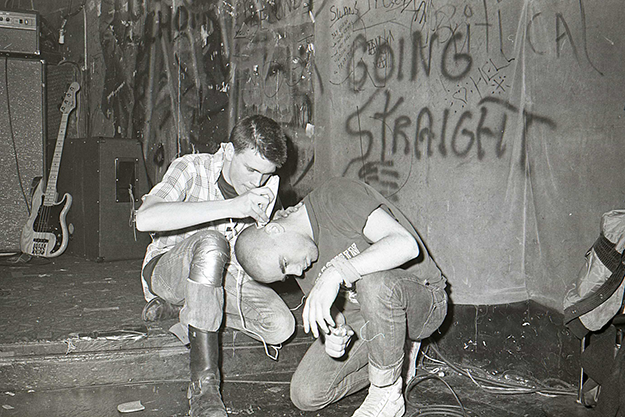
All Ages: The Boston Hardcore Film
The typical hardcore documentary next moves through the salient details of building a scene from the ground up, including a paean to the DIY work ethic, evoked through punishing rehearsal schedules and folding and gluing hand-silkscreened 7” sleeves and stuffing them into poly bags, all with no hope of material reward. Interviewees tell the stories behind local venues—Boston’s Gallery East and Media Workshop, D.C.’s Wilson Center, Chicago’s La Mere Vipere, O’Banion’s, and OZ—and indigenous bands, these talking-head segments interspersed with vintage video footage, in which kids can be seen practicing the regional variation of the “H.B. strut,” and dynamic still photography. (Salad Days draws heavily from the portfolio of images in Banned in DC, a 1988 collection of photos by Cynthia Connolly, who appears in the film and was interviewed for the book’s recent reprint.) Finally, we arrive at the dissolution of everything that had been built up, as the fights get out of control and the bullies take over the scene. The antisocial postures and ironically employed verboten imagery, originally intended as a “Keep Out” warning to scare away poseurs, eventually wind up bringing in honest-to-God sociopaths and fascists—and it’s On to Greener Pastures.
Aside from this inevitable melancholy coda, the hardcore docs are unified by their almost uniformly affirmative tone—something which sets them apart from the likes of firsthand accounts Another State of Mind or The Decline of Western Civilization. Spheeris, who would’ve been in her mid-thirties at the time when her film was released and had some perspective not available to most of her subjects, certainly wasn’t afraid to leave her interviewees twisting in the wind, often displaying a less-than-idealized version of themselves. In the latter-day hardcore docs, however, one can count on one hand the moments of discomfiture that occur while discussing a music that was devoted to confrontation. Offhand I can think of one moment in American Hardcore when it is strongly inferred that the electronic musician Richard Melville Hall—better known by his stage name “Moby,” or as M.H. when he played guitar for the Darien, Connecticut hardcore band Vatican Commandos—is lying about his claim to have briefly served as an interim singer of Flipper. Elsewhere in the film, Black Flag member Kira Roessler expresses her discomfort at Raymond Pettibon’s cover for the band’s 1984 release Slip It In, which she describes as “making fun of women”—one of a handful of instances throughout the movies in question where the macho bluff of one scene or another is called into question. Finally, You Weren’t There gets some mileage out of an old, rankling rivalry between Steve Albini and Vic Bondi, front men of Chicago’s Big Black and Articles of Faith, respectively, with Albini knocking Bondi as a “check-my-correct-politics-type hardcore front man” whose protest lyrics were so many “gestures of compliance.”**
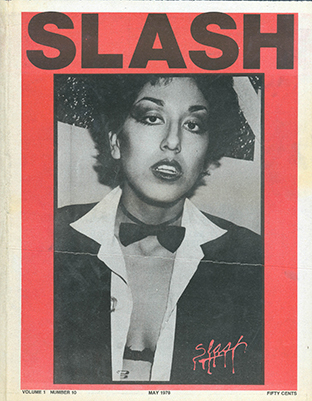 Elder statesman Albini’s music may have fared better in posterity—The New Rolling Stone Album Guide has even redacted the one-star Big Black reviews from the 1992 edition—but the vigorous cross-examination of politically suspect art now rules the day, and it will be interesting to see how a new generation of viewers negotiate a work as “problematic” (a currently popular synonym for “alive”) as Decline. All of this might be lost on someone approaching this material lacking a historical context in which to place it or the curiosity to seek out that context for themselves—witness an article called “The Comedic Gold of The Decline of Western Civilization” which ran after a BAMcinématek screening of the film, in Pitchfork’s “The Pitch” section, which insofar as I can tell is the home for provocative thinkpieces untouched by editorial meddling, the idea being that imposed fact-checking might slow the self-assured rhetorical velocity. For the article’s author—who I will not identify by name because she is 21 years old and really ought to have faced the scrutiny of a conscientious editor, and also because she has four times as many Twitter followers than me and really doesn’t need the publicity—the scene documented by Decline is “bloody, sexist, and racist . . . a gritty blueprint of young, white, male aggression” over which hangs the threat of “assault, violent racism, homophobia, or anti-Semitism.” While the author does make note of the fact that one no-name interviewee is seen wearing a swastika T-shirt, she either doesn’t know or believes it irrelevant to her condescending argument that Slash writer and Catholic Discipline member Phranc, and Germs front man Darby Crash (who cries out his lover’s name during a ramshackle rendition of “Manimal”), are both iconic queer performers; that a great many of the street rats going to the shows were almost certainly selling their asses to survive; and that Alice Bag is a Mexican-American born Alicia Armendariz, and Black Flag drummer Robo is a Columbian-American named Julio Valencia. To offhandedly dismiss the scene documented in Decline as “white and male” is to disregard the enormous contributions made to it by artists who were neither, as well as those who were both.
Elder statesman Albini’s music may have fared better in posterity—The New Rolling Stone Album Guide has even redacted the one-star Big Black reviews from the 1992 edition—but the vigorous cross-examination of politically suspect art now rules the day, and it will be interesting to see how a new generation of viewers negotiate a work as “problematic” (a currently popular synonym for “alive”) as Decline. All of this might be lost on someone approaching this material lacking a historical context in which to place it or the curiosity to seek out that context for themselves—witness an article called “The Comedic Gold of The Decline of Western Civilization” which ran after a BAMcinématek screening of the film, in Pitchfork’s “The Pitch” section, which insofar as I can tell is the home for provocative thinkpieces untouched by editorial meddling, the idea being that imposed fact-checking might slow the self-assured rhetorical velocity. For the article’s author—who I will not identify by name because she is 21 years old and really ought to have faced the scrutiny of a conscientious editor, and also because she has four times as many Twitter followers than me and really doesn’t need the publicity—the scene documented by Decline is “bloody, sexist, and racist . . . a gritty blueprint of young, white, male aggression” over which hangs the threat of “assault, violent racism, homophobia, or anti-Semitism.” While the author does make note of the fact that one no-name interviewee is seen wearing a swastika T-shirt, she either doesn’t know or believes it irrelevant to her condescending argument that Slash writer and Catholic Discipline member Phranc, and Germs front man Darby Crash (who cries out his lover’s name during a ramshackle rendition of “Manimal”), are both iconic queer performers; that a great many of the street rats going to the shows were almost certainly selling their asses to survive; and that Alice Bag is a Mexican-American born Alicia Armendariz, and Black Flag drummer Robo is a Columbian-American named Julio Valencia. To offhandedly dismiss the scene documented in Decline as “white and male” is to disregard the enormous contributions made to it by artists who were neither, as well as those who were both.
“In the sold-out audience at BAM last week,” the Pitchfork article’s author writes, “it became clear that there was really nothing tough about Decline’s cast”—a flip, flabbergasting assertion that a college-educated audience from prosperous Neo-Brooklyn could see right through the fraudulence of South Bay squatters c. 1979. (To quote Circle Jerks’ “Defamation Innuendo”: “Four years college, you’ve got knowledge / A bachelor degree, you read and write / You think it’s right but don’t come down on me / You’re an educated jerk, write about us / I could squeeze you like a pimple / but I don’t need the pus.”) As the din demanding that art define itself beyond risk of being misconstrued becomes ever more deafening, asking viewers to decipher a tribal system of signifiers whose very purpose was to thwart, baffle, and intimidate outsiders becomes a tall order, and so instead we turn to the pseudo-sophistication of condescending to a past that we’re unequipped to reckon with on its own terms. Still, it’s heartening to see that even a museum piece like hardcore still has the power to disquiet—and enough to make you wish for a howitzer-force disruption to come along and shatter the heavy air of apathetic liberal smugness.
1. In preparing to do so, I asked David Wilson—filmmaker, programmer for the True/False fest in Columbia, Missouri, and former scene pitboss—for recommendations, to which he offered that “‘Interview with Ian Mackaye’ in a music documentary is like saying ‘beautifully shot on a DSLR’ in a short doc about a guy who repairs clocks. (Though I still have more time for his opining than most).”
2. I was myself a hardcore kid in the mid-to-late Nineties in Cincinnati, Ohio, a city which was more oriented towards various punk idioms (pop, street, crust, etc.)—I recently had the uncanny experience of discovering that a local band that I saw multiple times in my youth, Archie and the Pukes, had been included in a Killed by Death–style comp from Goner Records, meaning that my own personal timeline is now in the process of being exhumed and rediscovered. As pertains to hardcore, Cincinnati had a few bands but no distinct personality of its own, but was defined by its proximity to various fiefdoms: Cleveland specialized in moshy metalcore (Integrity, Ringworm), and its personality was distinctly East Coast and tuff; Louisville and Columbus were both firmly in the PC/vegan/touchy-feely camp; Dayton, while associated with several high-profile “indie” acts of the period, was also home to a straightedge posse called the Courage Crew, who, somewhat disconcertingly, Will Smith was rumored to have joined in the late Aughts, when he was apparently planning to make an FX TV series about them through his Overbook Productions. Not infrequently I traveled to Dayton for shows, and was present at one by the Buffalo band Snapcase during which someone (purportedly Courage Crew–affiliated) interrupted their set by throwing a cup of piss on front man Daryl. If anyone would like to interview me for an oral history, I can be reached through this website.



